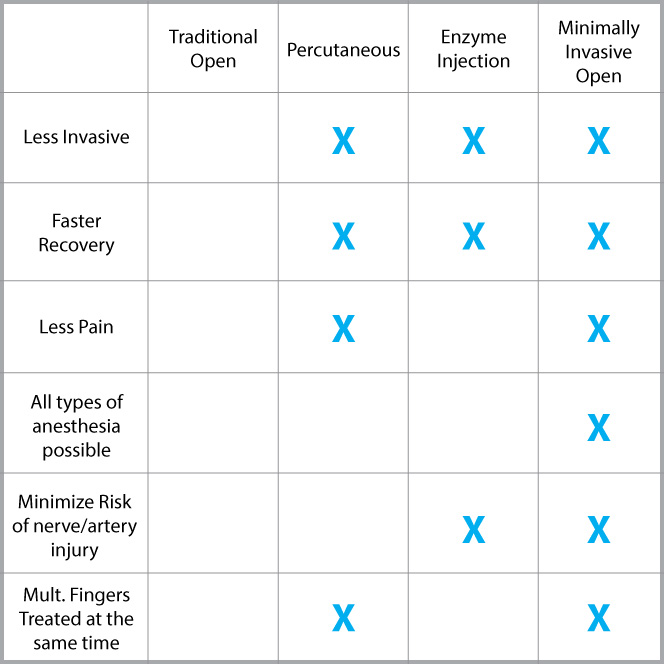4 surgical options for Dupuytren’s contracture Note: I have a favorite option
Surgery shouldn’t be a mysterious adventure where you pick an option, desperately hoping that you’ll like it only to find out that there was a better option available.
It’s the classic box of chocolates conundrum. If you don’t have a guide, you’re blindly choosing something that you hope has peanut butter inside rather than cherry filling, but you just don’t have enough information. Why take something as important as which chocolate piece to eat (or surgery to undergo) on faith?
May I suggest a little education is in order here? I will.
So here’s a primer on your surgery options for Dupuytren’s Contracture, and even if you don’t have Dupuytren’s contracture, knowing what some of the surgery types are will help you in other surgical situations as well.

1. Open surgery:
What Happens: A large incision is made where the hand is cut open so that the surgeon can see and remove the fibrotic (scarred) tissue.
Pros:
- The arteries and nerves to the fingers are visualized and protected.
- The entire scarred/fibrotic mass is taken out.
- Multiple fingers can be addressed in one setting.
Cons:
- Post-operative swelling can be severe
- Wounds can take many weeks to heal
- Skin grafts may be needed and extensive hand therapy is required.
- In some instances, patients can lose motion after surgery instead of gaining motion.
2. Percutaneous surgery:
What Happens: A sharp-edged needle is inserted into the hand and the fibrotic cords are simply divided. The finger is then able to be straightened out. Patient have to be awake and actively communicating with the surgeon, letting him/her know if they are feeling any electrical shock-like sensations in the fingers. This is critical to alert the surgeon that the needle is bumping up against a finger sensory nerve.
Pros:
- less invasive, less pain, less swelling
- faster recovery
- multiple fingers can be addressed in one setting
- it has to be performed under a local anesthetic.
Cons:
- Sensory nerves and arteries to the fingers are not visualized and can be inadvertently injured.
- General and regional anesthesia cannot be used.
- For patients who are anxious, this technique is not ideal. Patient have to be alert, awake and actively communicating with the surgeon.
- Skin tears take typically take two to three weeks to heal.
3. Enzyme Injections:
What Happens: NOTE: This option avoids any type of incision. A small needle is used to inject the enzyme into the Dupuytrens fibrous lump. The next day, the patient returns to the office where local anesthetic is injected into the hand to numb the area and the fingers are straightened out.
In patients with severe contractures, the skin often tears. The skin tears typically heal uneventfully with daily antibiotic ointment application over a two to three weeks.
Pros:
- Less invasive, less pain, less swelling
- Faster recovery
Cons:
- Only one joint of one finger can be addressed at a time.
- Depending on your case, it may require multiple treatments, which can be quite time consuming because patients must wait a minimum of one month between injections.
- The injection is painful.
4. Mini- open surgery (my preferred method if it’s appropriate):
What Happens: Multiple small incisions are strategically made over the affected fingers; the arteries and nerves are visualized and protected while the abnormal fibrous tissue is simply divided, which makes it possible for the finger to be straightened out.
Pros:
- Less invasive, less pain, less swelling
- Faster recovery, multiple fingers can be treated during the procedure.
- It can be performed under a general, regional or local anesthetic
- The nerves and arteries are visualized and protected, decreasing the chance of injury.
Cons.
- The small incisions are typically left open and allowed to heal naturally over a two to three week period.
Results: The recurrence rate for all treatments are similar and reported between 30-50%
My recommendation:
If you have a simple mild or moderate single finger contracture, enzyme injections to dissolve the abnormal tissue is a very good option.
If you have more than one affected finger, or a severely contracted finger, my preference is to recommend mini open treatment because I can (1) choose the type of anesthesia appropriate for you (or whatever you may happen to prefer), (2) decrease the change of injuring your nerves, and (3) you’ll recover faster.
So if you’re planning to undergo surgery sometime soon or know someone who is, you now know your options.
Have questions or comments? Had any of these procedures? Please let me know in the comments.


